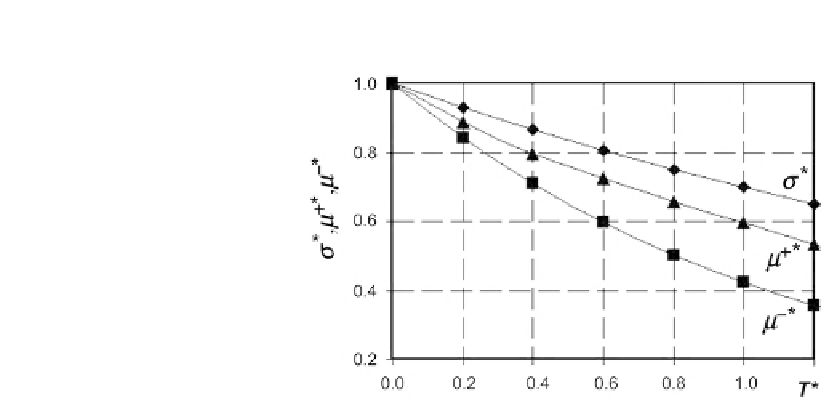Biomedical Engineering Reference
In-Depth Information
FIGURE 3.29
Variation of fluids' thermo-physical properties with temperature.
For the situation considered, the variations of density, specific heat, and thermal conductivity
with temperature are not considered. The densities of both fluids are set
to be identical
m
3
1700 J/(kg
C) and
ðr
¼ r
þ
¼
1000 kg
=
Þ
. The specific heats of oil and water are
c
p
¼
4200 J/(kg
C), respectively. For thermal conductivity,
k
0.17 W/(m
C) and
k
c
p
þ
¼
¼
þ
¼
0.6 W/
(m
C).
This problem is governed by the species conservation (Eqn
3.1
), the Navier-Stokes (Eqns
3.3 and
3.4
), and the energy (Eqn
3.6
) equations. Again, the level-set method is required to capture the
interface of the droplet. For the species conservation equation, the diffusion coefficient is set to
D
10
8
m
2
/s. The zero-flux condition is applied at the four walls of the enclosure. For the Navier-
Stokes equations, a no-slip condition is enforced at the four walls of the enclosure. For the energy
equation, the four walls are maintained at
T
¼
25
C.
The merging process of the droplets is depicted in
Fig. 3.30
. The temperature, velocity, and
concentration fields are plotted sequentially in the first, second, and third columns, respectively. It can
be observed that the three droplets are driven toward the center of the enclosure where the temperature
is highest. Because of the proximity of droplets 1 and 3 and the smaller size of droplet 3, these two
droplets are first merged (
t ¼
1.0
10
3
s). Then surface tension acts to minimize the surface area of
the merged droplet by restoring the droplet into a more circular shape (
t ¼
¼
10
3
). This newly
1.3
10
3
). At the
end of the merging process, the concentration of species X in this newly formed droplet has yet not
achieved equilibrium. Mixing of species X continues within this newly formed droplet.
merged droplet is then merged with droplet 2, forming an even larger droplet (
t ¼
1.4
3.6.8
Mixing within a droplet driven by electroosmotic flow in an enclosure
Figure 3.31
shows an enclosure containing an oil droplet suspended in water. Initially, the droplet of
radius
R
m is located at (150, 45). Only the lower half of the droplet contains species X.
A voltage difference of 200 V is applied across the two ends of the enclosure. An electroosmotic flow
of water is induced and hereby set the droplet into motion.
¼
22.5
m



Search WWH ::

Custom Search